Highlights of Tunesia
White dromedaries are real runners
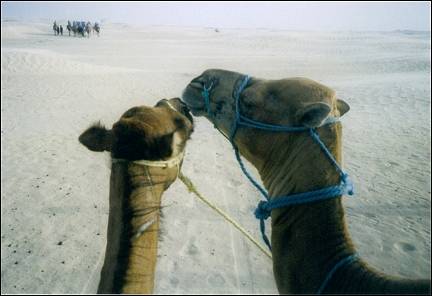
|
A tour of highlights like the Ribat of Monastir, the thermae of Carthago, the medina of Tunis, Kairouan, the foothills of the Atlas mountains with gorges and mountain oases, the salt plains of Chott el Djerid, the cave dwelling of Matmata, the spice market in Gabes, Djerba, and last but not least the Roman amphitheater of El Djem. And for dessert a dromedary ride.
Travelogue & photos: Angélique Woudenberg
Ribat of Monastir
Monastir - Port el Kantaoui - Sousse
Immediately after our arrival we visit the Ribat of Monastir, a fortified monastery from the eighth century on the Gulf of Hammamet. It was used to protect the population against attacks from the sea. The Ribat has a courtyard surrounded by small cells where the soldiers/monks slept. The courtyard is currently used for performances.
Before we can enjoy the view of Monastir we have to climb narrow steps and that isn't easy. It's still early, but it's already getting hot.
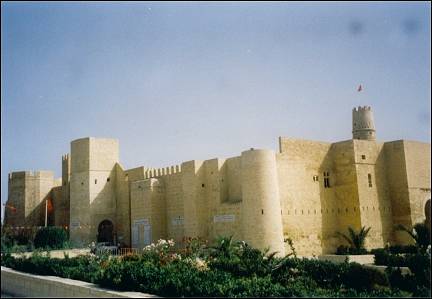
|
We walk to the other side of the Ribat, where former President Habib Bourguiba's mausoleum stands. Bourguiba was the first president of Tunesia; he held this office from 1957 to 7 november 1987. Bourguiba was born in Monastir.
Bourguiba fought for the independence from France, modernised the country, introduced compulsory education, the prohibition of polygamy and the emancipation of women. He outlawed veils and headscarves, as we will see during the rest of the week.
The mausoleum has three domes: two small green ceramic domes and a large dome covered with gold leaf. Bourguiba's tomb is below the golden dome. In the courtyard of the mausoleum we see pretty ceramic tiles, mainly in green and yellow. These two colors are symbols of Islam.
We drive to Port el Kantaoui, a port that reminds us of Cap d'Agde in France. We don't feel as if we're in North Africa at all.
In the evening we take a walk in the town center and on the promenade of Sousse. It's still hot and the streets are crowded with Tunesians taking a walk. Remarkably, only men sre sitting in outdoor cafés. There are no women in sight at all.
The Thermae of Carthago
Sousse - Port el Kantaoui - Enfida - Tunis - Carthago - Sidi Bou Said - Tunis (ca. 200 km)
We leave early for Port el Kantaoui where we spent time yesterday morning. We look at different aspects of the port town today: around the port are nice apartments, built in Moorish style, which means they are bright white.
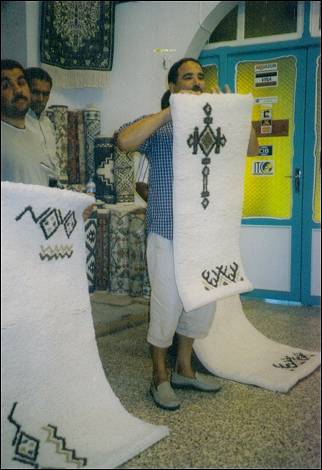
|
In Enfidha we visit a local weekly market. It looks like a flee-market. It's very busy, chaotic, and people are shouting. There are all kinds of merchandise: shoes, clothes, carpets, wooden doors, wooden beds, printed mattrasses, houseware, etc.
We were instructed not to take pictures of local people without asking them first, because some people here consider a camera the evil eye. It's a pity, because we see women in hijabs wearing gigantic earrings, with tatoos on their weathered faces.
We drive to Tunis, the capital, where we visit the Bardo Museum. It was originally a palace. The halls with mosaics are within the former harem, which is also decorated with beautiful ceilings and chandeliers.
After lunch we drive to Carthago. Our hostess tells us about the different types of plant life we see on the way. What we see are not coconut palms but date palms, which mainly grow in oases, as we'll find out. The eucalyptus trees along the road are supposed to clear the air of car exhaust and to stop erosion. The olive trees, which are called "zeituna" are considered sacred. Cactuses also help to counter erosion and they are also used as natural barbed wire fences.
Once in Carthago, we enter a modern neigborhood with villas: this is the location of the remains of thermae from Roman times. First we get to see a scale model of the original thermae. When we see the ruins a little later, it's still hard to imagine that these once were Roman thermae.
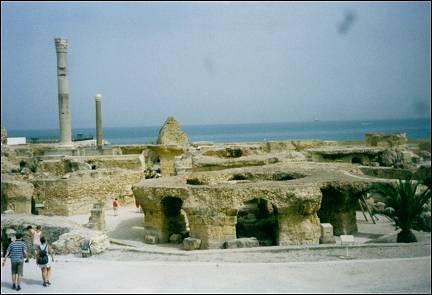
|
To the left of the thermae is the palace of the current president Zine El Abedine Ben Ali, so we are ab-so-lute-ly not allowed to take pictures.
Next we drive to the artists village Sidi Bou Said. The village is known for its use of the colors blue and white: white houses with blue doors, window frames and iron grids. White protects against the heat and blue is supposed to scare away insects. Protection from the heat sounds like a good idea, it's boiling hot again. We have a great view of the port and the Gulf of Tunis.
Medina in Tunis
Tunis - Kairouan (ca. 175 km)
"Saba el chir," or: Good morning. We leave early for the Medina in Tunis, which is the oldest Arabian city. The bus drops us off in the main street, Avenue Habib Bourguiba. At the end of the street is the gate to the old city.
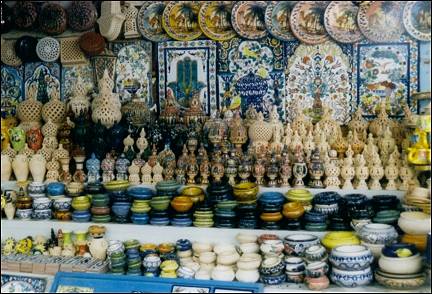
|
Behind this gate, Porte de France, lies a square on the other end of which there is an entrance to the medina. Inside the medina are souks (markets). There are two entrances; the left one is the most interesting for tourists. In the streets behind it you can bargain with souvenir vendors.
The entrance on the right is the most interesting for Tunesians. On that side the merchandise is fabrics, shoes and linens and it is possible to get your hands or feet dyed with henna.
We enter the left entrance first. We walk up a narrow alley and to our left and right we see even more narrow alleys. When we pass stores, we hear the merchants call "Maroc, Portugal, Spain, Egypt?" because they want to find out where we are from. As soon as we say we're from Holland, they lose interest. Almost all storekeepers say, in Dutch: "Kijken, kijken, niet kopen" (Just looking, not buying). One sales person even says "Hollanda no capital", in other words: the Dutch don't have money.
After an hour we've seen enough and it's stifling hot again. We walk leisurely on the modern, wide Avenue Habib Bourguiba. There are modern buildings, many banks, female police officers and women dressed in western fashion, whithout veils or scarves. But in the outdoor cafés we still only see men.
Cafés double as employment agencies. Employers visit cafés to hire new staff. They are also places where the men hear the news if they don't have radio, tv or newspaper at home. Many in the older generation are still illiterate. The newspapers are read out loud in cafés, so they stay abreast of current affairs.
In the middle of the roundabout at the bus station stands a large clock. In the past there was a statue of the former president, but all statues of Bourguiba, except for three, were removed and replaced with large clocks or statues with the number 7: this number stands for the day (7 november 1987) the current president Ben Ali assumed office.
We leave and travel south to the fourth holy city of Islam, Kairouan. The other holy cities are Mecca, Medina and Jerusalem.
Kairouan used to be a caravan serail. The word "kairouan" means caravan. One of the five pillars of Islam is that every Muslim should make a pilgrimage to Mecca at least once in his life. Because not everyone can afford to do that, one can instead visit the holy city of Kairouan seven times.
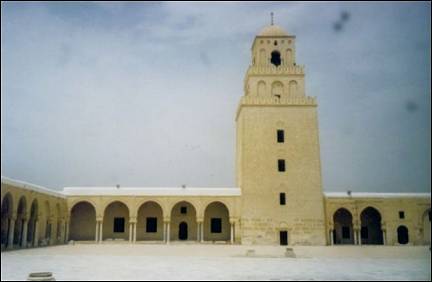
|
Non-Muslims can visit the Great Mosque Sidi Oqba between prayers, but never on Fridays when there are religious services.
This mosque is the holiest building in Tunesia and it looks like a fortress. At the entrance you can rent a shawl to cover your shoulders and knees.
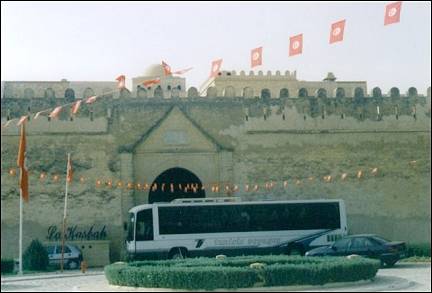
|
The large courtyard is surrounded by gates. Five times a day a cassette tape is played with the call to prayer, through loudspeakers on the 35 meters high minaret. The prayer hall is covered with carpets and mats. Non-Muslims are not allowed in here.
The pulpit and prayer hall are directed towards the holy city of Mecca. In front of the minaret, to the right, is a sun dial.
We visit Sidi Sahbi's mausoleum; the name means "my friend" and refers the prophet Mohammed's friend. The friend died in Kairouan and his coffin in the mausoleum is covered with a green cloth. According to legend, the barber Sidi Sahbi kept three hairs from Mohammed's beard with him all his life. We can only take a look at the coffin from the entrance.
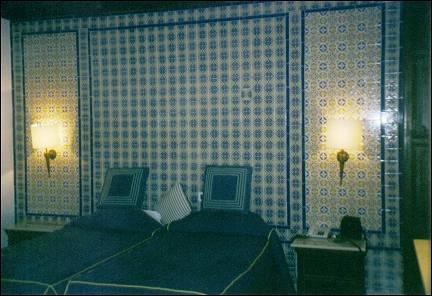
|
Around the courtyard we see pretty ceramic tiles and some doors we are not allowed to open. Behind one of those doors new-born babies are blessed and boys are circumcised.
An arid prairie landscape
Kairouan - Sbeïtla - Tozeur (ca. 350 km)
We drive south-west from Kairouan to Sbeïtla. On the way we see a landscape without trees, only graas grows there. It's a steppe or prairie landscape. The river beds are all dry and instead of cars we now and then see a donkey pulling a cart loaded with families or goods.
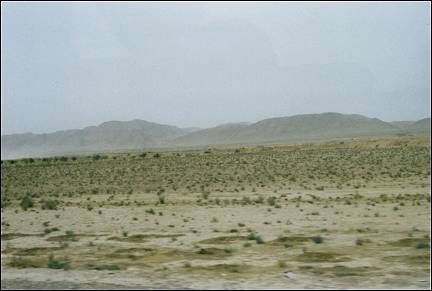
|
Mainly in Central and South Tunesia there is no running water, so every now and then we see women walk with a pail to get water from the well.
We take a walk in the former Roman city of Sufetula, currently Sbeïtla. There are ruins of houses, a hole that used to be a toilet, a former brothel and to the right of the Roman gate are ruins of stores on the "main street" of Sufetula. The Roman gate has three entrances which all give access to the market place or Forum.
On the highway to Tozeur we see sand dunes that are formed by the Sirocco, a hot wind that originates in the Sahara, in this barren region that is completely exposed.
In Tozeur we notice that there are brick buildings. Quite different from the mud houses we saw before. We visit the Dar Cherait Museum. It is built in the shape of a Tunesian house with rooms around a courtyard with ceramic tiles.
Every room exhibits typical Tunesian objects or traditions: men taking a bath in a hammam (bathhouse), women in the kitchen, dolls dying their hands and feet with henna, a Tunesian bride, glass cases with jewelry, utensils, clothing, etc.
In the streets we see many women with large black wraps with a white or blue edge, so-called sefsaris. They have nothing to do with Islam, but serve to protect the clothes, a kind of coat, as it were.
We take a carriage ride in the Tozeur oasis, a date palm forest. After a 15 minutes drive we take a short walk in the oasis with a Tunesian guide. He tells us what kinds of trees we see: banana, fig, lemon and tangerine trees and of course date palms.
An old man shows us how quickly he climbs to the top of a date palm to pick dates.
The Atlas foothills
Tozeur - Tamerza - Chebika - Chott el Djerid - Douz (ca. 200 km)
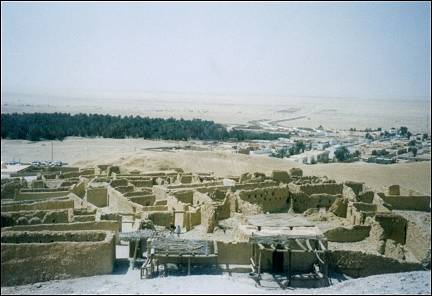
|
In the morning we leave in six Landrovers to visit the deserted mountain villages of Chebika and Tamerza. We share our Landrover with three others, which is a luxury: in the other cars are six to seven people.
Our driver is in a good mood today. As soon as we are on the highway, he speeds at 130 k/p/h, and he doesn't slow down on steep roads. On the way he sings Arabic songs.
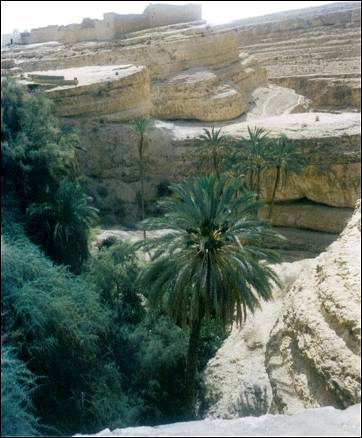
|
We didn't expect the roads to be this good. Every now and then we hit a bump, but the driver alerts us in time, by hitting the dashboard with his hands. As soon as we have passed a bump, he shouts: "Very good, very nice, chickie chickie easy."
We drive along the foothills of the Atlas mountains and in the distance we see the border between Tunesia and Algeria. Our first photo-op stop is in the deserted village of Tamerza. Part of the movie "The English Patient" was shot here.
The next two photo stops are in a mountain oasis with waterfall, and the 150 meters deep Seldja gorge.
On the way back to Tozeur our driver again speeds at 130 k/p/h. And yes, of course we are stopped by the police.
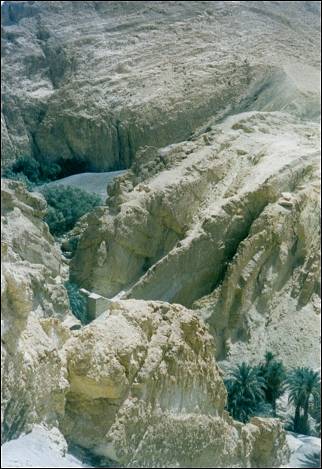
|
They take his driver's license. After 15 minutes he gets it back with a warning. After this, he slows down to 70 k/p/h, but once we're out of sight of the police, he suddenly makes a left turn onto a dirt road strewn with rocks and he again increases his speed to 130 k/p/h.
At first it's a nice adventure, but when you are being shaken and literally launched from your seat, without safety belts, you just hope you'll survive the ride.
Thank God this ride doesn't take long, and once back on the road it turns out we have cut off 5 km of our route.
In the afternoon we leave Tozeur, and drive via the salt lake Chott el Djerid and the town of Kebilien Kebili to the entrance gate of the Sahara, Douz.
Chott el Djerid is the largest salt plain of Tunesia. We expected a vast white plain.
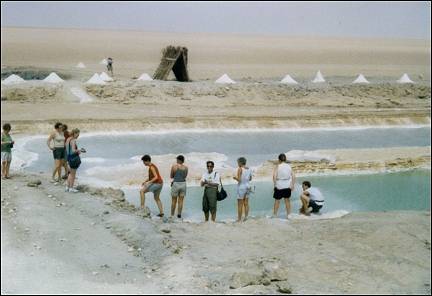
|
But unfortunately it is a vast brown plain with ditches along the road that hold different colors of water: pink, purple and light-blue. The colors depend on the mineral in the soil.
We get out and wash our hands in the salt water. It softens our hands and is supposed to help against eczema.
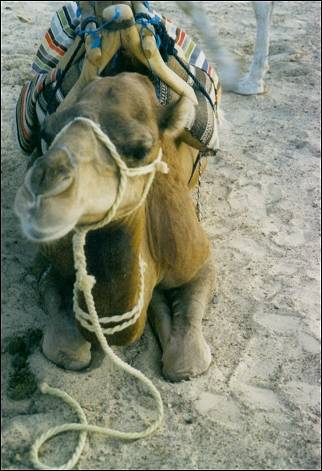
|
At the end of the afternoon we have to pick up djellebas and head scarves in the hotel store. The sales person helps us and wraps the head scarf all around my face, so only my eyes are visible.
We walk outside, to the dromedaries who are waiting for us. There are many tourist groups, each with a different color headscarves. There are white and brown, old and young dromedaries. The white dromedaries are real runners and the brown ones are better at carrying heavy things on their backs.
I pick a young brown dromedary. Before we can sit down on our dromedaries, we have to lift our djellebas and hold on to the saddle roof. It's scary when the dromedary gets up, but it's not that bad. We ride on the white Sahara sand at a leisurely pace for half an hour.
The cave dwellings of Matmata
Douz - Tamazret - Matmata - Medenine - Eiland Djerba - Guellalla - Houmt Souk (ca, 300 km)
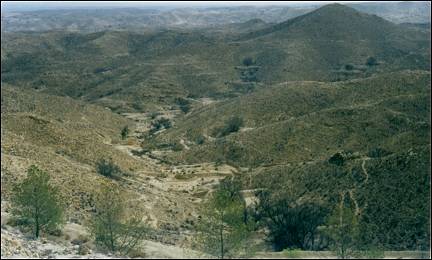
|
Today we leave the Sahara and drive to the cave village Matmata. It's a long ride. At first the surrounding landscape is a seemingly never-ending stone desert.
Before we visit the underground cave dwelling in Matmata, we stop to take pictures from above of the moon landscape with craters. Each crater is a dwelling. This landscape was used to shoot scenes for "Raiders of the Lost Ark" and "Star Wars".
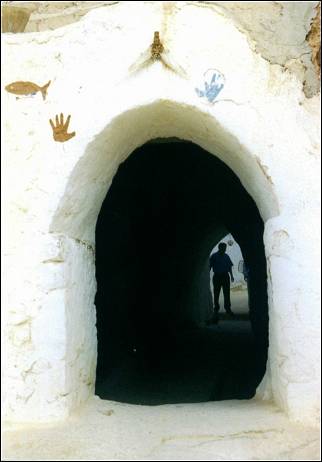
|
In Matmata we visit Fatma and her family. Mother, son, daughter and grandchildren are Berber and they really live here. The cave dwelling has a kind of entrance gate, or front door. Above it are two images: the hand of Fatima and a fish. The five fingers of the hand represent the five pillars of Islam and they protect against misfortune and the evil eye. The fish represents wealth.
Via a dark tunnel we walk to the courtyard, where mother Fatma gives us a warm welcome. She has opened several doors for us to take a peek. We see a small kitchen, bedroom and a living room with tv and electricity. There is no running water (yet) and the inhabitants depend on a water well.
All rooms can be accessed from the courtyard; every room has one more floor above it which in the past was used to store goods. The rooms have niches in which knicknacks are displayed. The beds and sofas are made of leather.
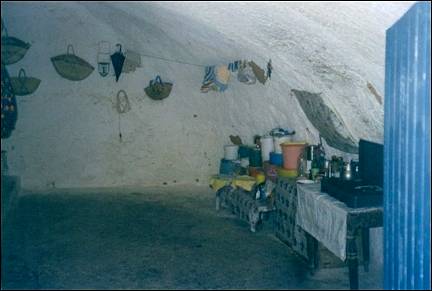
|
In the summer the cave dwellings are nice and cool. And during the winter nice and warm. We give the mother some money. The family lives off tips from tourists.
We pass through the village of Matmata Nouvelle, New Matmata. Former cave dwellers live here in houses. President Bourguiba thought that cave dwellings ruined the landscape and decreed that the people who lived there should move to regular houses. But many cave dwellers have returned to their caves.
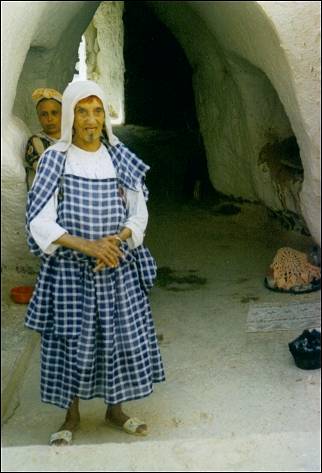
|
The Berber are the oldest inhabitants of Tunesia; originally they had blond hair and blue eyes. They still have their own spoken language, but no written one. They make up 3-4 percent of the Tunesian population.
Nowadays the Berber have mixed with the Tunesians who originally have dark hair and eyes.
We are on highway G1 from Tunis to Cairo, a distance of about 3,000 kilometers. We are near Libya, and we see lots of trucks with Lybian license plates.
Along the road are stalls with jerrycans filled with gas. It is cheap Lybian gas which is sold at a nice profit here.
We make an extra stop in the village ("ksar") of Médenine. It used to be a place where goods from Lybia and Africa south of the Sahel were stored. Merchandise was stored in so-called ghorfas, granaries, around a courtyard.
We continue on to the isle of Djerba, a distance of 74 kilometers. The island can be reached in two ways: by ferry or by road, via the Roman dam. The latter is what we do. Along the road we see water pipes which provide the island with water from the mainland. On the right side is the Gulf of Gabes.
Djerba is also called "the island of the Lotus eaters" or "pottery island". The latter refers to the pottery village of Guellalla.
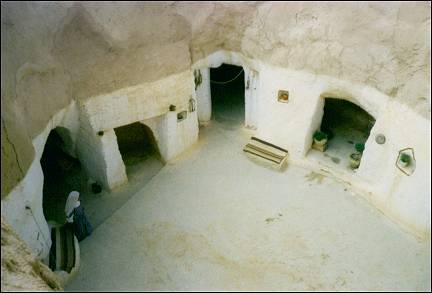
|
After lunch we visit a pottery workshop in Guellalla. We watch a man making a saucer and a jar; there is a store that sells the products, cups and saucers, tiles, etc.
In the capital Houmt Souk we have two hours to shop. We expected more of this capital, whose name means "marketplace". There is a mini-passage, two squares with outdoor seating, and of course souvenir stores that all sell the same junk. We are done shopping in a short time.
Originally we were going to visit the synagogue, but after an attack in 2002 this excursion was taken off the program. Our hostess tells us a legend about the synagogue: "Long ago, a beautiful girl lived on Djerba. People didn't know what her religion was. One day lightning struck her house. Everything was burned, except for the girl's body. The girl had a smile on her face, which made the people of Djerba think she was a saint. In this spot the synagogue was built."
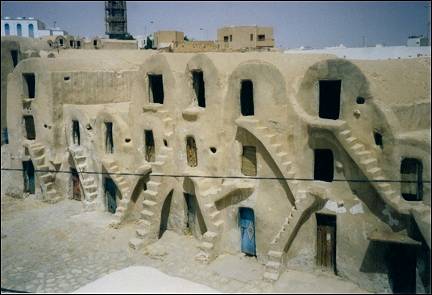
|
On the way back to our hotel we pass typical Djerban houses, called menzels. The houses stand far apart and don't have windows. They are bright white and are similar to the housed in Sidi Bou Said.
The original inhabitants of Djerba are short and have high, round foreheads. Women wear the traditional white sefsari (wrap) with an orange edge, and a straw hat.
Chopped off cow-, sheep-, and goatheads
Djerba - Gabes - Sfax - El Djem - Sousse (ca. 300 km)
We leave for Adjim very early and take the ferry to the mainland there. The crossing takes about twenty minutes. Unfortunately we don't get to see dolphins.
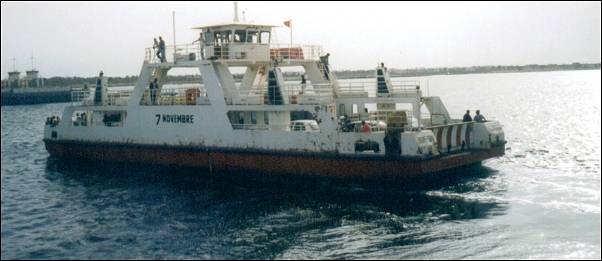
We drive to Gabes. This is the fourth biggest city of Tunesia, after Tunis, Sfax and Sousse. That it's a big city is immediately apparent from the chaotic traffic.
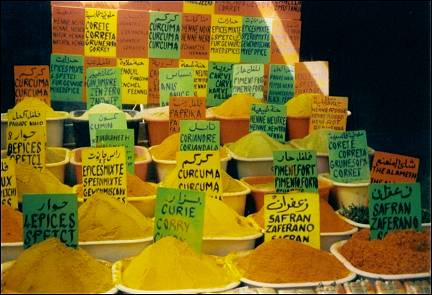
|
We vist the indoor spice market, which offers spices, henna powder, ethereal oils, jewelry, wicker baskets, slippers and real shishas (waterpipes).
Behind the main street we walk on a street which has only fruit and vegetable stalls. In a different street there are only clothes and shoes.
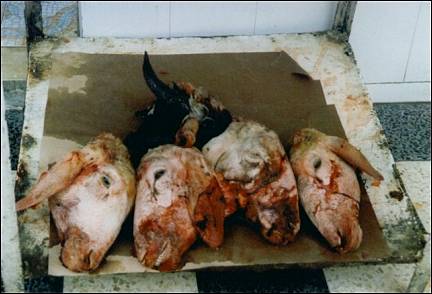
|
Behind this street is another one with only butchers. Here we see chopped-off cow-, sheep-, and goatheads, complete with eyes and teeth. Blood is dripping from one of the cow heads.
Gabes is the only city in Tunesia with a sea oasis. The dates that grow there are of lesser quality, because the palmtrees grow in salt water. Lots of henna plants are grown in and around Gabes, which explains why the market is also called "henna market".
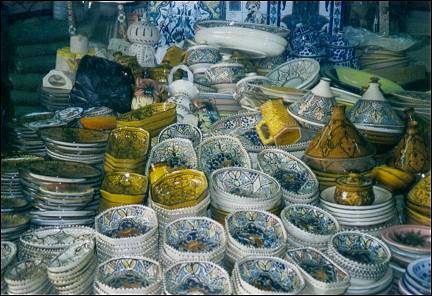
|
We drive to Sfax, the second biggest city of Tunesia and the center of phosphate winning. Along the road we see several road restaurants for the local population. The restaurants are marked by dead animals hanging in front of the entrance.
Outside is a barbecue on which the meat - f.i. dromedary - is immediately grilled. Dromedaries are used in many ways: their milk is drunk after a woman has given birth, the hide is used to make bags, their wool is woven into blankets and their turds are burnt to chase away insects.
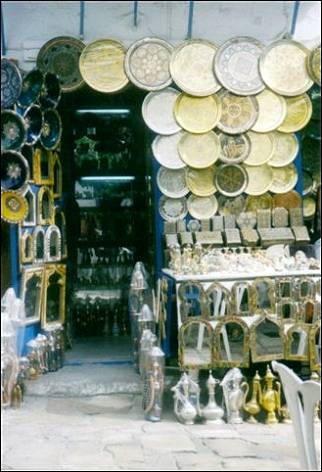
|
Our last stop on this trip is to visit the amphitheater in El Djem, the former Roman colosseum Tsydrus in which gladiators used to fight and, in later times, criminals were thrown to the lions.
In the Roman era, the amphitheater's well-preserved stands seated about 35,000 visitors. We get a short tour and the hostess points out the lion cages and drink bowls. Nowadays there are open air concerts during the summer. After the one in Rome, this is the largest colosseum in the world.
In Sousse we take a last walk in the evening through the city center and on the promenade.